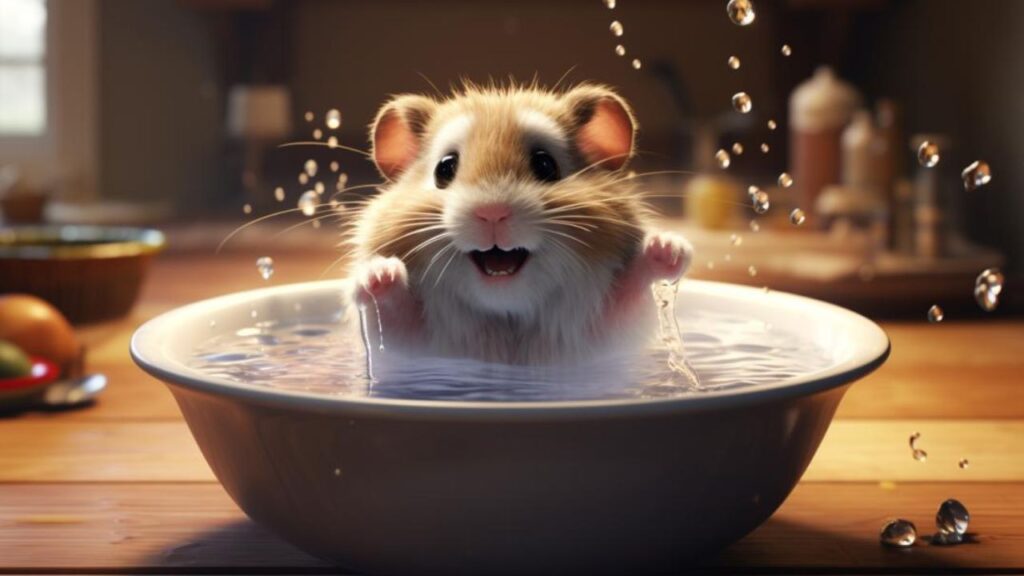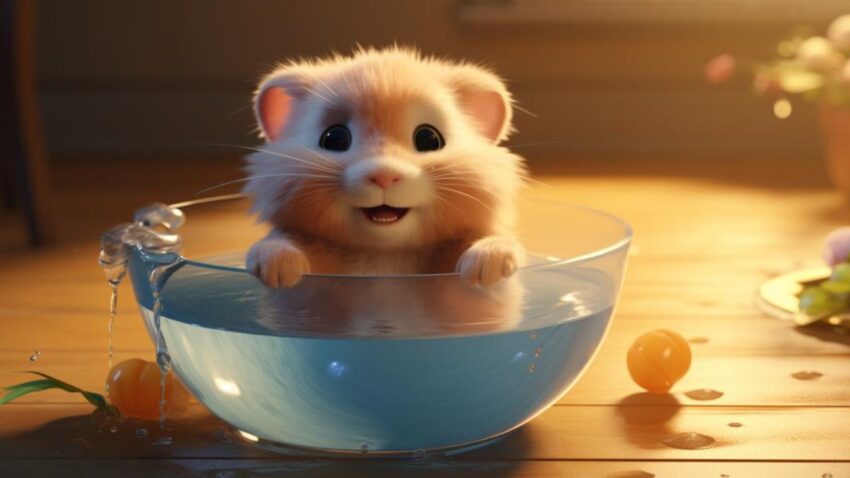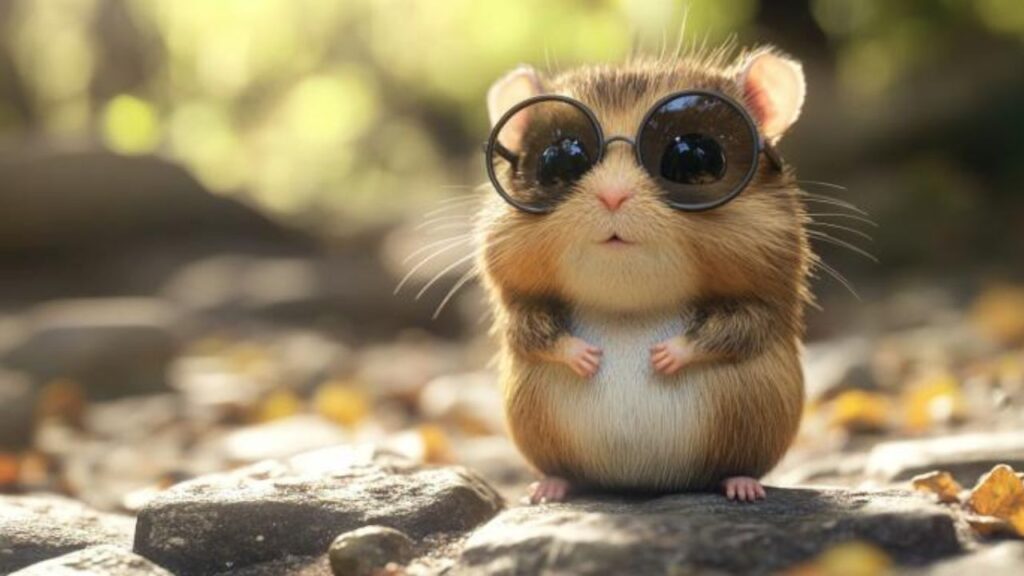TL;DR Summary
Yes, hamsters can drink from a bowl, but it requires careful management. Bowls should be shallow to prevent drowning, heavy enough to avoid tipping, and cleaned daily to ensure water purity. Monitoring your hamster’s water intake is crucial, as changes can indicate health issues. While water bottles are more commonly used and prevent contamination, bowls can also be suitable with proper oversight. Ensuring your hamster stays hydrated is essential for their well-being. Remember, a happy hamster is a wheel-y happy you!
Hydration plays a pivotal role in the well-being of all creatures, great and small, and the humble hamster is no exception. These tiny furballs, known for their cheek-stuffing antics and nocturnal wheel runs, require a steady supply of fresh water to maintain their health and vitality. Proper hydration aids in their digestive processes, keeps their kidneys functioning efficiently, and helps regulate their body temperature.
The Thirst for Knowledge: Hamsters and Their Water Sources
A hamster’s water consumption might seem like a straightforward aspect of pet care, but it’s a topic that often bubbles up with various considerations. Among these, the question arises: can hamsters drink from a bowl? While water bottles have long been the go-to for many pet owners, some in the hamster community advocate for bowls as a more natural option, aligning with how these animals would encounter water in the wild.
The Hydration Debate: Bowl vs. Bottle
The debate between providing water in a bowl versus a bottle is not merely a matter of preference but one of understanding the nature and habits of hamsters. It’s essential to weigh the behavior, safety, and health benefits associated with each option to ensure our furry friends stay properly hydrated.
As we embark on this discussion, we will dive into the sea of facts surrounding hamster hydration, evaluating the suitability of water bowls for these delightful rodents. Will the bowl hold water when it comes to meeting the hydration needs of hamsters, or does the bottle keep its status as the reigning champion of the water dispensing world? Let’s quench our thirst for clarity on this subject.
Understanding Hamster Hydration

Hydration is as vital to the small, bustling life of a hamster as it is to any other living creature. For hamster owners, ensuring that their furry companions have constant access to water is a fundamental aspect of care. But what is the best way to provide that water? Let’s delve into the typical methods of hydration for hamsters and dissect the advantages and disadvantages of each.
How Hamsters Typically Quench Their Thirst
In the wild, hamsters may find water in dewdrops, rain puddles, or moisture-laden vegetables. In captivity, we replicate this natural hydration through:
- Water Bottles: These are the traditional method, often attached to the side of the cage with a metal spout for the hamster to lick.
- Water Bowls: Some owners opt for bowls or dishes placed within the cage, offering an open surface from which hamsters can drink.
The Pros and Cons of Water Bottles and Bowls
Water Bottles: The Elevated Hydration Solution
Pros:
- Cleanliness: Water bottles help keep the water free from bedding and food debris, ensuring it remains clean.
- Less Spillage: They are less prone to being tipped over, reducing the risk of a wet cage and the accompanying health hazards.
- Controlled Drinking: The design allows hamsters to drink at a steady pace, which can prevent overconsumption.
Cons:
- Chewing Risk: Some hamsters may chew on the spout or the plastic parts, which can lead to damage or potential ingestion of plastic.
- Learning Curve: New hamsters may need time to learn how to use the bottle if they haven’t encountered one before.
Water Bowls: The Down-to-Earth Drink Option
Pros:
- Ease of Use: Bowls are more natural for hamsters to use and don’t require the learning that bottles do.
- Multiple Drinkers: Bowls can be advantageous if you have more than one hamster sharing a cage, as they can all drink at once.
Cons:
- Contamination: Bowls can easily become contaminated with bedding, food, or waste, which requires frequent cleaning.
- Risk of Wetness: There’s a higher chance of water spillage, leading to a damp cage environment that can promote the growth of harmful bacteria and fungi.
The Feasibility of Bowls for Hamster Hydration

When it comes to quenching a hamster’s thirst, pet owners have traditionally turned to the trusted water bottle. However, the use of water bowls is a topic gaining traction among hamster enthusiasts. Let’s wade through the details to assess the practicality of using bowls for hamster hydration.
How Hamsters Drink from Bowls
Hamsters are naturally adept at drinking from flat surfaces, as their ancestors would lap up dew or rainwater. A bowl caters to this instinctual behavior:
- Easy Access: Bowls provide an open source of water that hamsters can approach from any direction, making it easier for them to drink whenever they please.
- Natural Posture: Drinking from a bowl allows hamsters to maintain a more natural and comfortable body position, which may be beneficial for older or infirm hamsters.
Evaluating the Safety and Cleanliness of Bowls
While bowls may seem like the more natural choice, several factors must be considered to ensure they are a safe and clean option for hydration:
Safety
- Stability: A bowl must be heavy or secured in place to prevent tipping, which can not only deprive a hamster of water but also wet their bedding, leading to cold and unsanitary living conditions.
- Drowning Risk: Very shallow bowls are recommended to minimize the risk of smaller hamsters accidentally falling in and being unable to get out.
Cleanliness
- Frequent Cleaning: Bowls require diligent monitoring and regular cleaning to prevent contamination from bedding, food, or waste.
- Fresh Water Supply: Owners must be vigilant in changing the water at least once a day to ensure that it remains clean and safe for drinking.
Water Bottles vs. Bowls: Hydration Solutions Compared
Water Bottles
- Pros: They keep water clean and reduce spillage. Bottles also discourage the growth of bacteria and fungi since the water is not exposed to the environment of the cage.
- Cons: Water bottles can malfunction, potentially leaving a hamster without water, and they may also pose a challenge for some hamsters who struggle to learn how to use them.
Water Bowls
- Pros: Bowls can offer a more natural drinking experience and are easy for hamsters to use.
- Cons: They are prone to contamination and require more maintenance to ensure the water stays clean.
Whisker Tips: Setting Up a Bowl for Your Hamster

For pet parents who choose the bowl over the bottle for their hamster’s hydration, there are some ‘Whisker Tips’ to ensure that this transition is smooth and that the bowl remains a safe and effective watering hole.
Choosing the Right Bowl for Your Hamster
Selecting an appropriate bowl is the first step in this process:
Size and Stability
- Shallow Depth: Choose a shallow bowl to prevent any risk of drowning and to make it easy for your hamster to reach the water without difficulty.
- Heavy Material: Opt for a bowl made from ceramic or a heavy plastic that your hamster cannot tip over or chew through.
Placement in the Cage
- Secure Area: Place the bowl on a stable surface within the cage where it’s unlikely to be knocked over by your hamster’s activities.
- Away from Bedding: Keep the bowl away from bedding areas to prevent bedding material from getting into the water.
Training Your Hamster to Use a Bowl
While hamsters will naturally drink from a bowl, there might be a learning curve, especially if they’re accustomed to a bottle:
Introducing the Bowl
- Initial Introduction: Place the bowl in the cage while still keeping the bottle present. This allows the hamster to explore the bowl at their own pace.
- Encouragement: You can encourage your hamster to investigate the bowl by placing a small piece of a favorite treat in the water to draw their attention to it.
Transitioning Fully to a Bowl
- Gradual Removal: Once you see your hamster regularly drinking from the bowl, you can gradually remove the water bottle.
- Monitor Hydration: Pay close attention to how much your hamster drinks from the bowl to ensure they are getting enough water.
Maintaining the Water Bowl
Ensuring the bowl is a hygienic source of water is essential:
- Regular Cleaning: Rinse and refill the bowl with fresh water at least once a day.
- Observation: Watch for signs of contamination, like food particles or feces, and clean immediately if found.
Maintaining Cleanliness and Safety

In the realm of hamster care, the cleanliness and safety of drinking water are as vital as the air they breathe. A clean, stable water bowl is a cornerstone of good health for these small pets, preventing a multitude of potential health issues.
The Imperative of a Clean Water Bowl
The water bowl is not just a vessel for hydration but also a reflection of the overall health environment within a hamster’s habitat.
Health Implications
- Bacteria and Contaminants: Standing water can quickly become a breeding ground for bacteria, especially if contaminated with bedding, food, or waste.
- Disease Prevention: Regular cleaning of the water bowl is essential to prevent the spread of diseases, which can occur when harmful pathogens are ingested through dirty water.
Cleaning Routine
- Daily Refresh: Change the water in the bowl at least once a day, or more often if it becomes soiled.
- Thorough Washing: Use a mild, pet-safe detergent and rinse the bowl thoroughly to ensure no residue is left that could harm your hamster.
- Disinfection: Periodically, it’s wise to disinfect the bowl with a solution appropriate for small animals, followed by a thorough rinse.
Ensuring Safe Access to Water
The placement and stability of the water bowl are just as important as its cleanliness for the safety and well-being of your hamster.
Strategic Placement
- Elevated Platforms: If possible, place the bowl on a flat surface away from bedding and high-traffic burrowing areas to minimize contamination.
- Accessibility: Ensure the bowl is easily accessible but not in a location where it can be easily knocked over during your hamster’s nightly explorations.
Stability of the Bowl
- Heavy-Duty Material: A heavy ceramic bowl is less likely to be tipped over by an active hamster and will stay put during vigorous drinking sessions.
- Secure Positioning: Some bowls come with attachments or slip-proof bases that can help secure them to the cage, ensuring they remain upright and in place.
Conclusion: The Essence of Hydration for Hamsters

As we conclude our exploration of the hamster’s hydration, we have stirred the waters around the use of bowls versus bottles. The journey has led us to understand that while bowls can be a suitable alternative for some, they come with considerations that require an attentive eye and a diligent hand.
Summarizing the Bowl Approach
The feasibility of using a water bowl for your hamster hinges on a few key practices:
- Choosing the Right Bowl: Opt for a shallow, stable bowl that your hamster can access without risk of tipping or drowning.
- Maintaining Cleanliness: Commit to a daily cleaning routine to ensure the water remains fresh and free from contaminants.
- Monitoring Intake: Observe your hamster’s water consumption with care, as changes in drinking habits can be early indicators of health issues.
The Ripple Effect of Water Intake Monitoring
Regardless of whether a bottle or bowl is used, the importance of monitoring a hamster’s water intake cannot be understated:
- Detecting Health Changes: Sudden increases or decreases in water consumption can signal health problems that may require veterinary attention.
- Ensuring Adequate Hydration: Regular monitoring ensures that your hamster is drinking enough water to stay hydrated, supporting their overall health and well-being.




